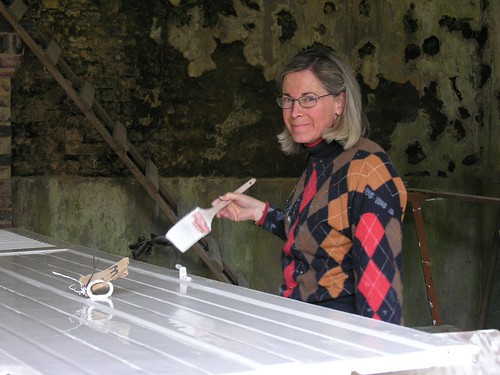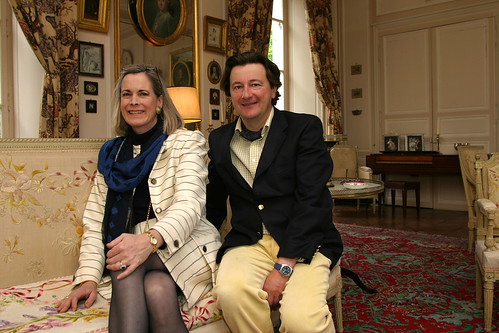La Vraie Vie de Château

I was curious to know what it’s really like to live in a historic château and what it takes to maintain and make it flourish in the 21st century and beyond. She reveals some of the highs and lows, and the sheer hard work involved in running the Château as an exclusive hôtel and venue for small, chic weddings. They welcome guests from all over the world.
Firstly Marnie, I know you’re American, did you spend all your early life in the States?
I was born in California of American parents (mother’s side from Virginia, father from Pennsylvania). My parents, however, left for Europe when I was 2 years old, so I never grew up in the States.
Most little girls dream of being a princess, living in a castle and maybe marrying Prince Charming, was that one of your childhood dreams?
Of course, as a child, my cousin and I used to disguise ourselves as princesses too… our vision of princesses. However, being a Countess living in a Château is far from the dreams and the image some glossy magazines give to it; that it’s a Hollywood or Jet Set lifestyle.
The reality is that if my fairy godmother were to appear now, I would only ask her for one thing “Chuck the Prince Charming bit and give me staff!’ Today, a countess must be prepared to roll up her sleeves and get things done around a large domain, from painting shutters to climbing ladders to clean clogged gutters.
Employees are not allowed to climb more than three steps by law! How can you clean windows in rooms that are 5 meters high? Well, the countess at 56 gets on the ladder while the employee hands her the cloths…
Being part of the aristocracy and owning a 600 year old château is about maintaining it for future generations. It is about obligations, not rights and showing off. It is about solid values of service, far from the society of rampant consumerism that has got our Western World into the present economic mess.
Did you meet Guy in France and did you know about his family history and the château when you met?
I met Guy when studying at University in Paris with his sister. I learned about his family history from her, from him, from their parents
It must be a huge responsibility owning such a historically important property; did you and Guy have to think twice before taking it on?
Rights must go hand in hand with responsibility or society ultimately breaks down. We saw this happen in 1789 and we are seeing it again today, only the “privileged class” has changed its name. Now it is the “corporatocracy” on one side and the “ayant droit” on the other, but it is the same mentality of little work effort, little competence, no moral obligations and indecent demands other people’s purses.
Our ancestor, the Marquis de Vanssay, went to Paris/Versailles in August 1789 to defend the rights of the local people he cared for and he knew their plight. He was even elected Head of the Republican guard on our château terrace by the people of the village and thus the Château remained in the Vanssay family throughout the revolution.
Yes, Guy and I did think twice, when his father died in 2002 and this “golden cage” came to us. In centuries before, a château was a gift to pass on; it came with land, farms and staff, in other words, the means for upkeep. Now it is a hot potato and a cage never feeds the bird… no matter how golden.
Guy actually was ready to sell so as not to put this burden upon me and our marriage, we even looked at some properties too, but decided that before chucking 600 years of history, we should at least do our best to try to restore the property, then see if it was viable. This is why we opened up to welcoming guests.
Last year we restored the family chapel. We hope that small and very elegant weddings in the future will pay for this expense which we paid entirely out of our savings with the help of some gifts from generous guests, no state subsidies or grants.
What sort of condition was the château in when you took it over?
The roof was alright, which was an enormous bonus, but the façade needed to be totally redone (a huge maçonnerie job), the gutters completely changed, water leaks repaired, electricity modernised throughout, landscaping reviewed, the forest cleaned up, and of course entirely redecorated.
It had a roof and heating, that is it and fossil fuel heating has tripled in the past ten years, it costs 20 000 Euros just to heat the place [per year].
How hands-on do you and Guy get when it comes to restoration? Can you ever be found with a paintbrush in hand, for example?
I have learned a lot, for example I am found every winter with more than just a paintbrush in my hand, painting is the easy part. I do the replastering and sanding prior to that and I’ve renovated most of the rooms entirely by myself. And I have pictures to prove it!
What is the best thing about owning a château?
Space and beauty and tranquillity and being able to live with lovely furniture and paintings and one’s animals. The satisfaction of working to transmit a heritage of past centuries to future generations, something that is part, not just of the family heritage but of the cultural and architectural richness of a region and a country and which conveys identity. A country that neglects it’s past and disregards its roots and history will only have a very limited future…
And what is the worst?
The anguish of constant maintenance and trying to make ends meet whilst praying there will not be another “bad surprise” calling for big repairs and the prevailing French local and national attitude that “they have a château, they can pay”.
With such a large property do you ever forget where you stored things, even quite large things?
It has happened, but I try to keep things organised, although this is time consuming, so often, when the season comes to an end, I find myself wondering where I quickly stashed this or that item that was lying around looking messy…
What is the most exciting or touching item left behind by former occupants that you’ve discovered during restoration work?

The upkeep alone must be hugely expensive, are you constantly having to think of innovative income generation schemes?
Absolutely, now we are turning our eyes to China and realising that we need to develop products that we can sell at high prices, so as to afford staff. If we can build in enough added value, we can up the price and this will pay for the extra staff that people expect in such a château.
This would enable us to employ more local people and stimulate the local economy. Guests come with a dream and that dream does NOT include the countess serving and cleaning. It breaks their dream if they see this, and reduces our margin further as a consequence. So we are currently setting up a product for a small group of VIP guests, who will be able to take over the château for three or more nights and we will then organise private receptions for them at neighbouring châteaux with the owners: a sort of “By Invitation Only” experience.
With the dwindling middle class, one must face up to the fact that most people either aim for the most discounted hotel or gîte and we cannot compete with that here, with our maintenance costs. So we have to aim at the lucky few for whom price is not an issue.
I know you welcome guests from all over the world; this must be very exciting but also a great challenge when it comes to catering for cultural and dietary differences, let alone the language barrier. Do you have to carry out research beforehand?
Of course we research heavily, so for example, when our first group of Chinese guests arrived in early October, I offered them their special Chinese breakfast of noodle soup, sliced roast chicken and shrimp, steamed ravioli and pork meat balls along with the croissants and hard boiled eggs.
For the Americans, we are constantly explaining that restaurants close at 1:30 pm and open again at 7 pm and that French people don’t graze but sit down to share a proper meal. The English expect tea to be offered in the afternoon and we must not forget the milk. But welcoming these different cultures from around the world is precisely what makes are days so interesting here.
Lastly what are your plans for the future of the château?
We plan to welcome fewer individual guests for one or two nights and to increase our bespoke, private offering to small VIP groups. This will be more lucrative and less tiring and should enable me to work until I am past 70 years old, we are far from being able to contemplate retirement at 60 or even at 62…
Will our son take over? We do not yet know, it depends upon whom he marries, what his wife likes, where she and he work. Times have changed and they will continue to do so and perhaps in 20 years time he will easily be able to work from the château ?
All images © Wendy wise









What an inspiring story! As a lover of all things history, I value it immensely that history is kept alive like this. Wish I could visit this Château to use it as a backdrop in my historic fiction… Thanks for the article!
Hi Milja, I’m so glad you enjoyed it, it was really interesting to write. If you can’t get to stay in the château, they have really reasonably priced cottages in the grounds and if you can’t do that either, there are several videos on You Tube, just search for Chateau de la Barre.